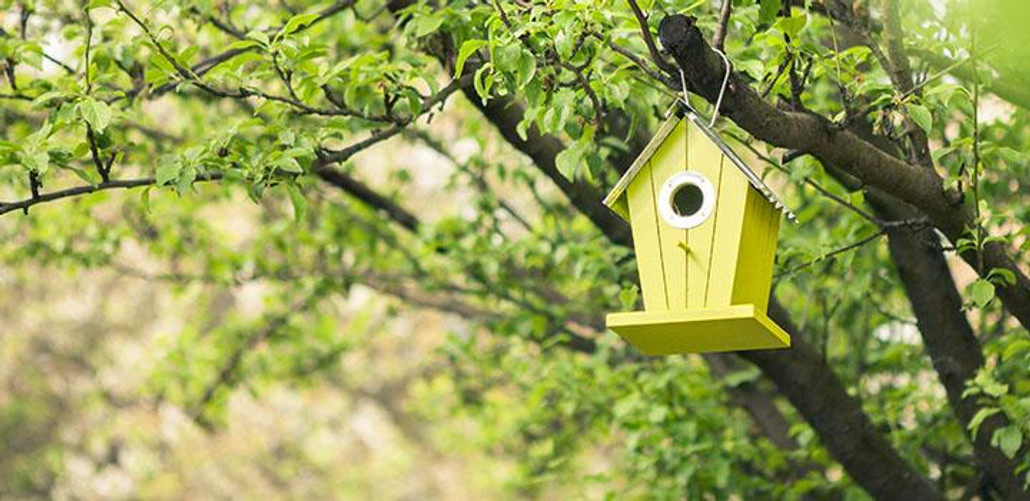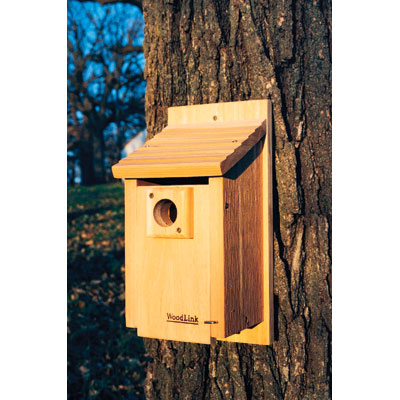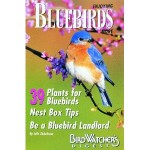
How to Choose a Bird House
Posted by Grange Co-op on 1st Feb 2016
The first step in choosing a bird house is to assess what type of habitat you live in and therefore, what birds might be inclined to use your nest box. Please note: Not all birds will use a nest box. Only birds that naturally nest in cavities of trees will use a box. Many of the birds that come to your feeders, such as Goldfinches, Pine Siskins, House Finch, Sparrows, Towhees, Juncos, Mourning Doves, and Hummingbirds make their own nest out of twigs, grasses, feathers, etc and will not use a man-made nest box.
 So, you might ask what birds will use a bird house? If you live near or in a wooded area, you might find the Chickadee, Titmouse, Nuthatch, Wren, Downy Woodpecker, Flicker, or Screech Owl interested in using a box. If you live in open meadow/farm country, you should look for Western Bluebirds, Tree Swallows, Violet-green Swallows, Kestrels, and Barn Owls to inhabit your boxes. If your habitat includes a water source, (pond, creek, river), you may find Wood Ducks looking for a nesting cavity. Swallows also tend to nest near water sources that are rich in producing mosquitos for food.
So, you might ask what birds will use a bird house? If you live near or in a wooded area, you might find the Chickadee, Titmouse, Nuthatch, Wren, Downy Woodpecker, Flicker, or Screech Owl interested in using a box. If you live in open meadow/farm country, you should look for Western Bluebirds, Tree Swallows, Violet-green Swallows, Kestrels, and Barn Owls to inhabit your boxes. If your habitat includes a water source, (pond, creek, river), you may find Wood Ducks looking for a nesting cavity. Swallows also tend to nest near water sources that are rich in producing mosquitos for food.
For those who live in the city, the primary birds using a nest box are HouseWrens and Robins. (Though Robins don't use boxes, they will use a robin roost which is a man-made 3-sided platform). After you have decided what type of habitat, (keep in mind your property may include several different habitats), you live in, you can choose a box that will be suitable for the corresponding types of birds. Please note: The entrance holes and sizes of nest boxes are specifically sized for different species of birds. Be sure to match up the correct box with the correct bird species. The type of nest boxes available include: wrens, chickadees/nuthatch/titmouse, bluebird/swallow, woodpecker/kestrel, flicker, barn owl, wood duck, and robin roosts.
A suitable nest box will include the following features:
- Untreated wood (pine, cedar, or fir - (treated wood can be hazardous to birds if eaten)
- Thick walls (at least 3/4 inches - (for insulation against heat and cold)
- Extended, sloped roof (helps keep inclement weather out of houses)
- Rough or grooved interior walls (helps baby birds to get out of the house when fledging)
- Drainage holes (for water and moisture drainage)
- Ventilation holes (for air flow in box)
- Easy access for monitoring and cleaning (human user- friendly to keep birds healthy)
- Sturdy construction (so families can be raised without houses falling apart)
- No outside perches (helps reduce predation on baby birds)
Now that you have chosen your
bird house you need to decide where to hang it up. As a general rule, most birds prefer their nest boxes to be roughly 5 - 10 ft. above ground level. (Nuthatches, Kestrels, Owls, and Wood Ducks tend to like them a little higher at 10 - 20+ ft. above the ground). Place the entrance hole away from prevailing winds and storms, (generally facing southeast as a rule). Remember to place the box so that you can watch any activity that occurs and where you can monitor and clean the nests out after each season with ease.
 Nest boxes should be up and ready by the end of April in the Rogue Valley area. I usually prep my boxes in February so I don't interrupt any potential home hunter. If you haven't seen any activity in your box within two years, try moving it to a different location. If you also feed the birds, be sure to place the houses away from your feeders so feeder activities won't interrupt breeding activities.
Nest boxes should be up and ready by the end of April in the Rogue Valley area. I usually prep my boxes in February so I don't interrupt any potential home hunter. If you haven't seen any activity in your box within two years, try moving it to a different location. If you also feed the birds, be sure to place the houses away from your feeders so feeder activities won't interrupt breeding activities.
Male birds, especially, are very territorial of their nesting spaces. Don't place nest boxes any closer than 10 ft. apart and for some species this distance may need to be longer. Shop bird reference books on specific species requirements, available at grangecoop.com and at your Grange Co-op in the "Wild Bird Country" section.
